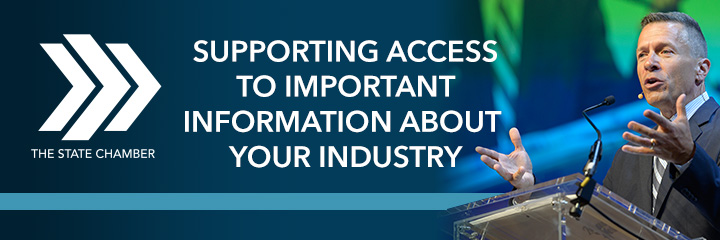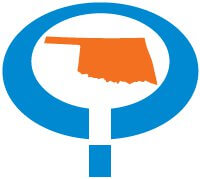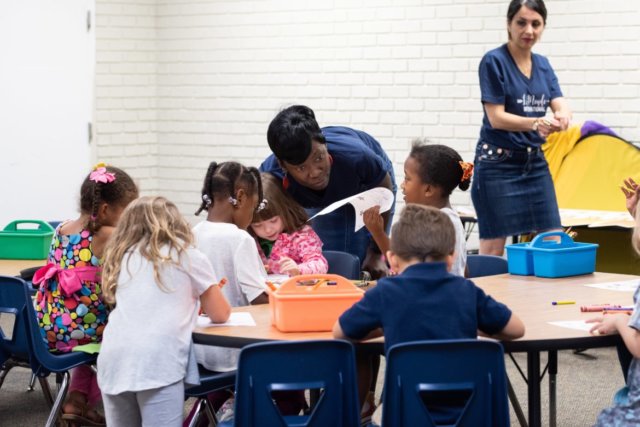

(Editor’s note: This story was authored by Jennifer Palmer of Oklahoma Watch and appears here in accordance with the non-profit journalism organization’s republishing terms.)
Students as young as 4 spend the day at Le Monde International School learning to speak, write and read in French or Spanish. On a recent day, a class of boys and girls greeted their principal with an enthusiastic “Bonjour!” Another class crafted Eiffel Towers out of craft sticks.
The state’s newest charter school offers students a language-immersion, arts-integrated curriculum, books and supplies. What it doesn’t have: a playground, a library or a cafeteria.
If location is everything, charter schools in Oklahoma are struggling. There are charter schools operating in portable buildings, office buildings, shared space with colleges, and even a botanical garden (complete with tourists peeking in the windows). New and expanding charters are popping up in vacant retail space near major highways.
The sites often barely resemble schools.
But charter schools are facing increased pressure to grow, and many have lists of students waiting for space. Charter-school leaders say they can’t afford to build new buildings because, unlike district schools, state law doesn’t allow them to issue bonds or receive property taxes. The schools do receive state aid and federal funds.
Because of the restrictions, many charter schools make do, relying on gifts, grants, loans and general-fund dollars to repurpose all kinds of buildings. Students sacrifice certain things to attend.
But charter officials are pushing harder to get more public dollars. The state Senate recently held an interim study on the topic of charter school funding, and a lawsuit filed last year against the State Board of Education seeking equitable charter-school funding is still pending. Nothing has been filed in the case since December, however. There is also talk of pushing legislation next year to address the issue.
“These are public school kids with substandard facilities,” said Chris Brewster, superintendent of Santa Fe South Schools, an Oklahoma City charter system with 2,400 students and nine schools in buildings that were formerly schools, a bar, an armory, a YMCA, a hardware store and a department store.
The armory, which is now Santa Fe South’s early childhood center, once contained a shooting range, and the Department of Environmental Quality found asbestos, lead dust and lead-based paint in 2011. It was cleaned up in 2012. The nightclub that now houses the charter’s sixth-grade center still has a dance floor and a bar, though the bar is stocked with bottles of paint and art supplies instead of booze.
Public school leaders have pushed back, saying that in a state ranked among the lowest in per-pupil funding, they can’t afford to have local tax revenue diverted to charter schools. The attorney for Tulsa Public Schools wrote in a court filing that the district stands to lose at least $1 million in the first year alone if virtual and non-virtual charter schools receive a share of local taxes. “The financial impact … would increase every year and quickly diminish the district’s necessary — and scarce — revenue, the majority of which is restricted-use building fund revenue that is vital to the district’s capital improvement projects,” the attorney wrote.
In the recent interim study, one charter-school leader, Barry Schmelzenbach, principal of Harding Fine Arts Academy in Oklahoma City and president of the Oklahoma Public Charter School Association, suggested lawmakers could add a new weight in the state funding formula to address the problem. Other states have taken different approaches.
A temporary home
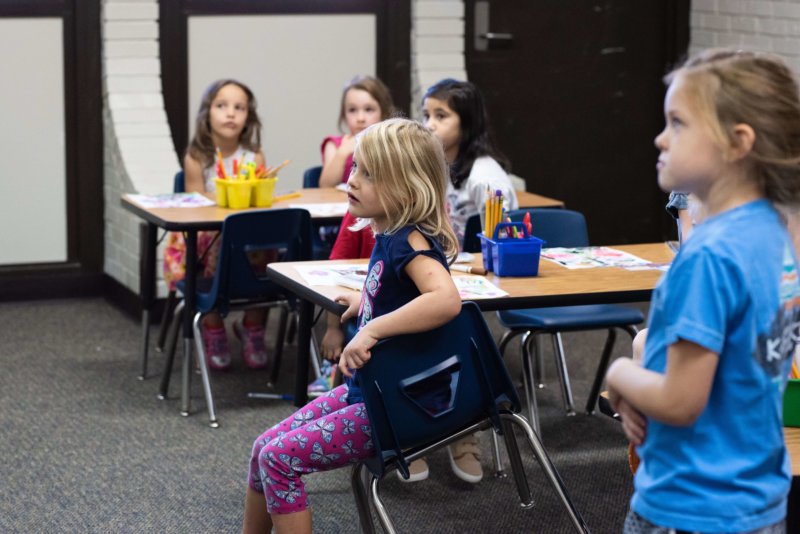
Leaders of Le Monde proposed five potential locations to the State Board of Education in their bid for sponsorship in March 2017. But in July, just weeks before the school year began, they scrambled to set up shop in a shared office building.
The space lacks a playground; the students have recess in a small outdoor space with some toys and balls. School leaders would like to add a playground and are trying to raise money for one, but they plan to move to a new location in two to three years, so they are making improvements with that in mind.
The school fills two wings of the building with a shared public hallway in between. Le Monde hired a security guard to escort students between the two.
The location caused some parents to choose another school for their children, said Lance Seeright, the school’s principal, but Le Monde still opened Aug. 29 with 134 elementary students.
Le Monde received nearly $1 million in grants for start-up costs — $600,000 from a U.S. Education Department program for creating and expanding charters across the country and $325,000 from the Walton Family Fund.
Oklahoma has 32 charter schools. Combined, the schools enrolled just over 29,000 students, with 12,000 of those in virtual charter schools, according to the state Department of Education. While that’s just 4 percent of all public school students, several new charter schools have been approved or expanded recently. Many more are expected to open in coming years because the schools are now permitted in rural areas and the federal Education Department grant, totaling $16.5 million over five years, will increase the number of charter schools.
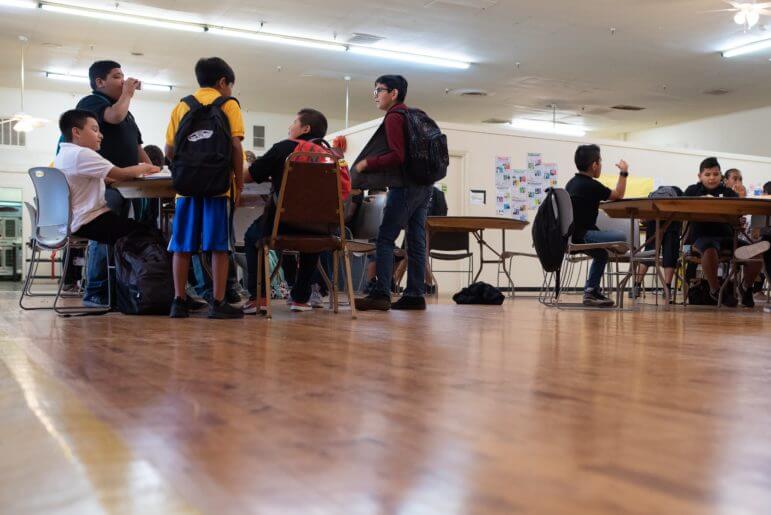
Oklahoma vs. other states
By their very nature, charter schools are somewhat more temporary: They can be closed by their authorizing entity or operator if they’re performing poorly. That may explain why the schools often open in short-term spaces.
Nationwide, 238 charter schools closed in 2017-18, nearly offsetting the 300 that opened that year, according to a report by the National Alliance for Public Charter Schools. A National Education Association task force found in 2017 that a third of charter schools closed within the first 10 years.
Of the 44 states and District of Columbia that have charter school laws, 33 provide direct funding for buildings, according to the Education Commission of the States’ analysis from January. The funding mechanisms vary widely.
None of those appear to use a weight in the funding formula as proposed by Schmelzenbach, although some, like Indiana, provide a per-pupil allocation specifically for facilities.
Other states, like Texas, give charters access to bond financing. The Texas legislature in 2017 also gave charters dedicated state funding ($60 million total in 2018-19) for leasing and maintaining buildings and facilities, which charter advocates spent years advocating for. Like in Oklahoma, Texas’ charter school association at one time sued the state for what it argued was inequitable funding.
Oklahoma’s current mechanisms for direct funding for charter buildings are the Charter School Incentive Fund and the Common School Building Equalization Fund. Both sit empty. The last time the Charter School Incentive Fund received an appropriation was in fiscal year 2016, and it was just over $49,000 and for new schools only, said Deana Silk, a spokeswoman for the education department.
The Common School Building Equalization Fund has never been funded, she said.
Charter schools do have one advantage in Oklahoma: they are provided 100 percent of state formula funding, while in some states they get 80 or 90 percent.
A bold move
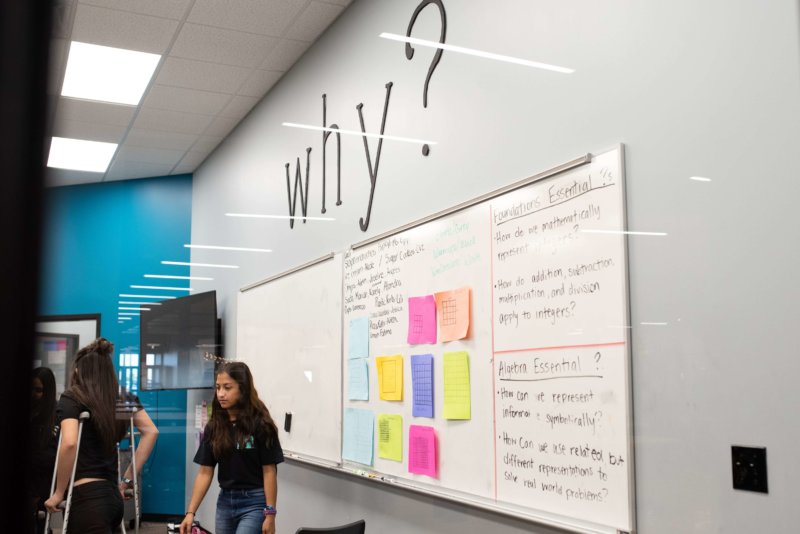
When Santa Fe South Schools inked a deal to invest $10 million in a new high school in an old department store, the mall had been somewhat revived — not exactly bustling, but occupied.
But in less than a year, the mall-turned-Hispanic-community-center announced it was closing its doors. The attempt to re-purpose the former retail center didn’t work, and the school had already started construction on one end of a 1.2 million-square-foot, suddenly empty retail center.
“It was devastating,” Brewster said of the mall’s announcement. The news dashed his “pie in the sky” dream to turn the building into a true community hub, with schools anchoring each end, a food court filled with eateries and service agencies in the interior.
Still, the high school project moved forward and opened in 2017, with more amenities than the school’s previous location – the old Shields Heights Elementary School, built in 1910. The new high school has modern art rooms and science labs, thoughtfully-designed classrooms and lots of parking for its 1,000 students.
Capital improvements of similar scope in a traditional school district would likely have been presented to voters for bond approval and taxpayers would have had the final say in whether to pay for them. But because Santa Fe South is a charter school and can’t issue bonds, Brewster funded the project in a deal with a Maryland-based nonprofit, Charter Schools Development Corp. It wouldn’t have been possible, Brewster said, without the rock-bottom purchase price of the building, at $1.8 million. Santa Fe South currently leases the building from the owner, Charter Schools Development, using state aid dollars to pay the rent.
“The disparity is stark in what public charter school kids get and what is given up in order for families and kids to be able to choose a charter school,” Brewster said. “We’re hopeful with some strong leadership that we’re going to see a legislative solution.”
That hope could rest on the results of the Nov. 6 election, when voters choose among dozens of candidates for the state House and Senate and select a governor. Many educators are running for legislative seats this year and favor increased education funding, especially in light of improving state revenues. A new mechanism for funding charter-school facilities could be part of negotiations over higher spending on schools, although other state agencies will also be lobbying to receive a boost in their budgets.
